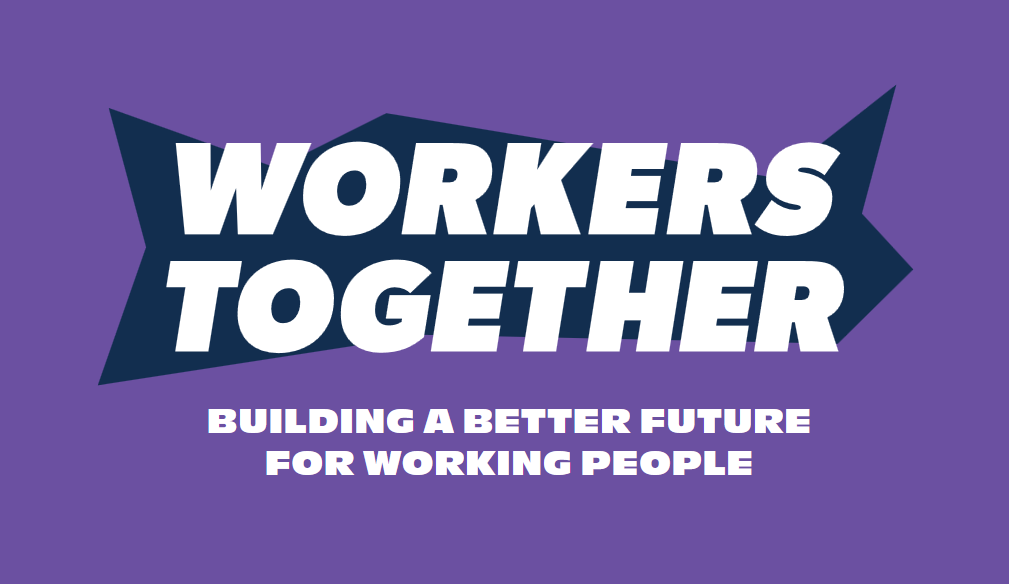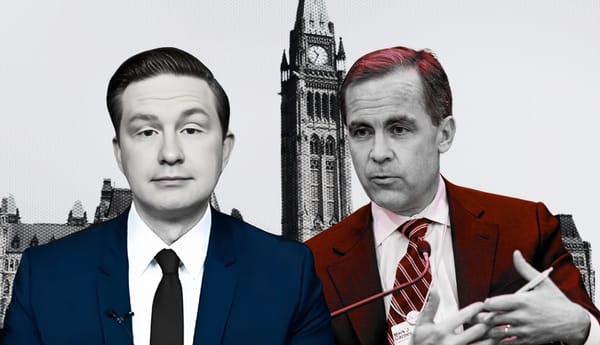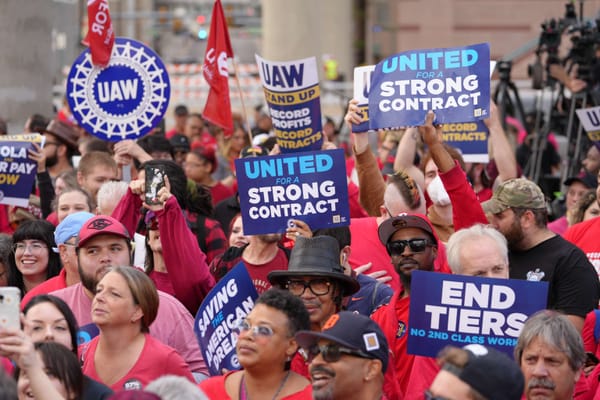
For this week’s Class Struggle newsletter, I had a conversation with economist Jim Stanford about public spending, deficits and debt, and what kind of program the left should demand in the aftermath of the pandemic.
Jim is director of the Centre for Future Work, based at the progressive think tank the Australia Institute, honorary professor of political economy at the University of Sydney, and the Harold Innis industry professor in economics at McMaster University in Hamilton, Ont. For more than 20 years, Jim was economist and director of policy for Unifor (formerly the Canadian Auto Workers), Canada’s largest private sector union. He is the author of Economics for Everyone, as well as many other books and articles.
Adam King: Let’s start by going back to the mid-1990s and early 2000s, and the Liberal governments of Jean Chrétien and Paul Martin. This period of “deficit fighting” is often invoked as an example of how to effectively deal with a “debt crisis.” Then-Finance Minister Paul Martin famously made a commitment to tackle the debt “come hell or high water,” which involved deep cuts to federal spending on public services and transfer payments to the provinces. Can you tell us what was going on in the 1990s and why it remains relevant for us today?
Jim Stanford: Canada’s federal governments ran up significant deficits through most of the 1980s and early 1990s. Importantly, these deficits were not the result of big increases in federal spending on public services or social programs. Rather, they were caused by the lousy state of Canada’s macroeconomy through most of the period.
We had a wicked recession in the early 1980s, followed by high interest rates to fight inflation — an intended consequence of which was very high unemployment. We then had another deep recession in the early 1990s, again caused by high interest rates, as well as adjustments to the new free trade agreement with the U.S. that had been implemented in the late 1980s. As a consequence, the government’s tax revenue was undermined and deficits increased. Again, this was not the result of “overspending,” but these were significant deficits and they did pile up.
By the early 1990s, Canada had a federal debt in excess of 60 per cent of gross domestic product (GDP). Conservatives and Liberals who wanted to see program spending cut began emphasizing the debt, and the need to cut spending to ‘get the fiscal house in order.’
Paul Martin, when he was Finance Minister, brought in an epic budget in 1995 which was a sea change in Canada’s fiscal and social policy, entirely motivated by this supposed “debt crisis” that we faced. The Liberals pledged to balance the budget within a four year period. In fact, their cuts went far deeper than was required to meet even that ambitious target. They ended up balancing the budget in two years.
The Employment Insurance (EI) system was absolutely gutted. After the cuts, most unemployed Canadians no longer qualified for EI. They then hacked away at the transfer payments that the federal government provides to the provinces for a whole range of programs and services, including healthcare and education.
But it actually turns out that these deep spending cuts weren’t even the key to balancing the budget. What actually happened was that the economy regained momentum, in large part because the Bank of Canada began to lower those high interest rates. With lower interest rates, a lower Canadian dollar and our manufacturing industry improving, the economy started to rebound. This is what generated the tax revenue to do most of the work of balancing the budget.
At the time, progressives argued that the cuts weren’t necessary to tackle the debt. History has proved us right. In fact, had the government instead prioritized economic growth, they could have met the same timetable without any federal spending cuts. The cuts were an ideological exercise engineered by people who wanted a less comprehensive system of income and social support. They seized on the deficit and debt hysteria to force through a program that was socially painful and that Canadians would have otherwise rejected.
Unfortunately, the legacy of those cuts remains with us today. When the COVID-19 pandemic hit, everyone knew our EI system was not up to the task of taking care of the millions of Canadians who lost their jobs due to the lockdowns. We had to implement emergency benefits to deal with the crisis.
AK: The pandemic certainly highlighted the consequences of these previous cuts and “reforms,” as well as the general inadequacy of Canada’s welfare state. But it also necessitated relatively high levels of public spending to deal with the economic fallout of the public health emergency. Some people on the left have asked if this marks the end of neoliberal hegemony. Are governments moving beyond the constraints of neoliberal orthodoxy or was this a temporary intervention?
JS: The orthodoxy around “balancing the books” at all costs was already eroding for several years before the pandemic hit. In fact, in the years after the Great Recession in 2008-09, even mainstream economists had to recognize that obsession with fiscal austerity, particularly in Europe, made the crisis worse than it had to be. In Europe, they paid for this absurd focus on austerity with regional crises in Greece, Spain, Portugal and Italy, and generally weak economic recovery across Europe.
With interest rates low, mainstream economists acknowledged that governments not only could maintain larger deficits, but in fact should do so. In a way, the seeds were already planted for a rethinking of monetary and fiscal policy, especially deficit spending, and particularly when confronting economic crises.
With COVID, everyone knew that government had to spend, and spend big, both to protect public health and to maintain spending power and prevent the economy from melting down. In Canada, we had a federal deficit equal to 15 per cent of GDP, which would have previously been unfathomable. This is the largest deficit since World War Two.
The federal government did it quickly and could finance it easily. The Bank of Canada for the first time began to create credit through a quantitative easing type of mechanism — until then Canada hadn’t done that — and it worked. This helped maintain spending power and keep interest rates low, and it helped government service this very large deficit. We now have federal debt as a share of GDP up around 50 per cent — though still lower than when Martin engineered his phony war on the debt. The present Liberal government isn’t in a rush to eliminate it, nor should they be.
Interestingly, the 2021 election was somewhat of a referendum on whether we should return to the fiscally austere “normal” approach or carry on some of these extraordinary measures. I think the sentiment of Canadians was clear. Before the ballots were cast, it was apparent austerity wasn’t going to win in this election. Even the Conservative Party stayed away from their doctrinaire infatuation with balancing the budget. They had a token statement about balancing it in 10 years, but in the meantime they proposed measures that would make the deficit bigger. The Liberals, NDP, Greens and Bloc all argued for more spending. The only party running on austerity was the Peoples’ Party.
This doesn’t mean we’re safe. I’m encouraged by the fact that austerity had virtually no traction during the election, but I’m not complacent about it. Right-wing forces within the Conservative Party are still banging the drum about austerity everyday. Business commentators and right-wing think tanks also say “it was fine to spend during the pandemic but now we have to get back to normal.”
This is not an argument about the technicalities of fiscal policy, debt-to-GDP ratio, or any other fine points of economic discussion. It’s ultimately about politics and priorities. It’s about segments of society that want government to do more to raise living standards and improve the wellbeing of Canadians fighting those segments that oppose this and will seize on the deficit and debt to fight it.
The pandemic further proved that those old austerity tropes are wrong. The pandemic showed that society and governments can mobilize enormous resources to support people. The only limit is our collective ability to work and produce. Money is not a barrier. That is an incredibly important lesson. We have to prevent the denizens of austerity from trying to stuff that lesson back into Pandora’s box.
AK: Let’s talk about what a coherent left program should look like. What kind of public spending agenda should progressives be pushing? It’s one thing to say we should expand public spending, but we should be clear about what we want to do with that spending.
JS: That’s very important. We can’t just come out and say “we’ve in favour of spending.” That goes for taxes too. That doesn’t convince people. I think there’s a knee jerk left response that says, “We’ll respond to these problems by taxing the rich.” I’m all in favour of taxing the rich, but that’s not how you solve a deficit problem, and you don’t put that ahead of your program. You need to tie taxation and spending to specific policy ideas. It’s about articulating what we want to do with society’s resources instead.
This is where I think ideas like the Alternative Federal Budget that the Canadian Centre for Policy Alternatives (CCPA) hosts every year are vitally important. The CCPA liaises with social movements, organizations and advocates, and develops an agenda that would help Canadians now and into the future, and shows how we could pay for it.
There’s no shortage of things we need to do, with the money raised but more importantly with the real material resources of society. We have to put people to work, for example in a universal, accessible and high-quality early education and childcare service. Our research at the Centre for Future Work suggests that a full rollout of a national childcare program would create approximately 200,000 jobs in the sector itself, plus an additional 80,000 jobs in the various industries that supply that childcare sector — including construction jobs to build new childcare centres. In addition, we could potentially see 725,000 new jobs for women whose labour force participation would be enabled by affordable childcare.
There are enormous advantages to be had by increasing the footprint of the state in the realm of human and caring services. Our public health capacity needs to be strengthened. Aged care and homecare, as well as other services for the elderly need major attention. Climate change, obviously, has to be met with resources, including public spending on green energy, conservation and public transit, as well as support and planning for the transition process of shifting workers from fossil fuel intensive jobs to sustainable work. That challenge is entirely manageable. We can phase out climate damaging industries and provide good jobs in other climate-friendly industries. But it takes resources and political commitment.
The challenge for the left is to make this not an abstract debate about fiscal targets but a concrete program that shows what kind of society we want to live in. If we can mobilize what I think is a clear desire among Canadians for government to do more, I think we can win some big changes.
AK: When Trudeau called the last election, it seemed as though the Liberals sought a majority government to reign in some of the more ambitious spending that the pandemic necessitated. How would you assess the left’s prospects under the incoming Liberal minority government?
JS: Many people thought the election was a waste of time and money. It obviously reflected an effort by the Liberals to get a majority. That shouldn’t surprise us — every political party tries to capitalize on what it thinks are opportunities like this.
I think, even though the election outcome was a parliament more or less the same, it nevertheless did send a strong message. So I disagree entirely with those who say the election was pointless. Austerity was defeated and we saw this reflected in the parties virtually all proposing spending increases. This is a very good thing.
It’s also good that we ended up with a minority government. The Liberals wouldn’t be as ambitious with a majority in parliament. There’s a strong historical analogy here to 1965 when Lester Pearson, who headed a minority government, called an election hoping to achieve a majority but only gained three seats — the same number that the Trudeau Liberals just gained — and fell short. Pearson then had Tommy Douglas and the NDP pushing him from the left to do more and go faster. In those next two years, we got national medicare, the Canada Pension Plan, the Canada Assistance Plan, a student loans program and several other important initiatives.
Justin Trudeau is clearly no Lester Pearson. But, if we can push both the Liberals and the NDP — I don’t trust any party to put the interests of working Canadians first — to mobilize resources and improve the living standards of average Canadians in the face of the crises we face, we could win some great things. We need to demand that they fully implement childcare, that they extend emergency income support, that they fix EI once and for all and that we meet the challenge of climate change with investments in renewable energy and support for fossil fuel worker transitions.
It ultimately depends on how we mobilize. Right now, I’m afraid it’s the anti-vaxxers and other right-wing elements doing all the mobilizing. We need unions, social movements and activists to get in the face of this new government and demand more.







